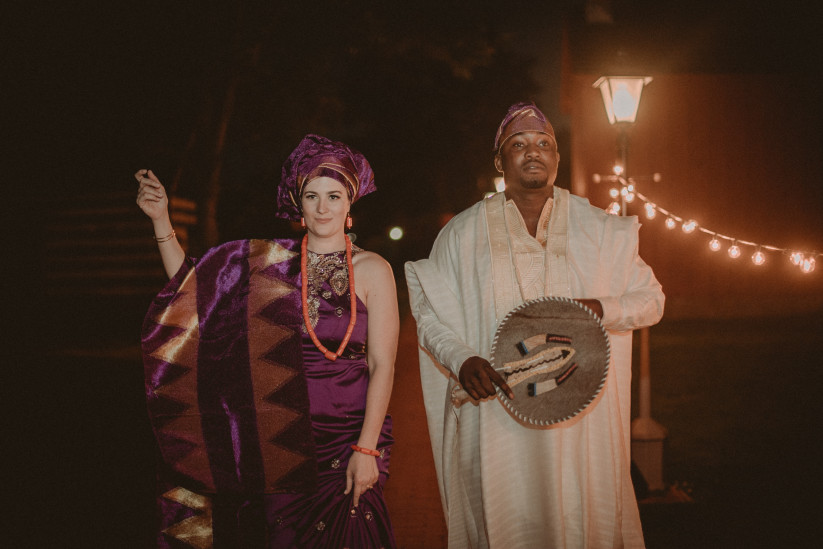
Photo: Amy Anaiz Photography
If you are planning a wedding in Nigeria, you probably already know that you have some very big shoes to fill. Nigerian-American couples and their families look forward to hosting a lavish, all-night party with hundreds of guests and mountains of food. While you probably have an idea of your wedding’s theme and color palette, you might need some inspiration before you start going into the details of your big day.
Table of Contents
See how these creative Naija couples designed their Nigerian wedding.

Photo: Rare Magic Gallery
Coordinate fabrics for a hint of unity
Wedding couples do not tend to agree very much on American or Nigerian marriage customs. You can break the mold a bit by choosing a unifying fabric for you and your love to wear at the wedding. Try using the fabric for one couple’s dress and then again for another couple’s headdress, like this couple’s rich purple outfit. Or, if you’re both going West, add some traditional Nigerian with a pocket square, belt, or other wedding accessory made from Nigerian fabric.

Photo: Bakerture Photo & Video
Mix traditional Nigerian culture with American customs
Planning a Nigerian wedding in the United States can be challenging if you have always dreamed of a western wedding and a Nigerian wedding. Fortunately, other couples wonderfully blended their shared cultures with hints from each other. Wedding attire is a great way to show your pride in both cultures by swapping the dress at your reception. In this way, you are in Western clothing for the ceremony and Nigerian clothing for the reception (or vice versa). Beyond the dress, don’t feel pressured to go full of Naija with your wedding food. Add your favorite foods from other cultures to the menu along with all the jollof and fufu your heart desires.

Photo: Rare Magic Gallery
Take your table outdoors
Creative wedding furniture ideas are plentiful, but an outdoor love table cabana is definitely unique. If you are planning a Nigerian outdoor wedding, this table alternative is a great mix of traditional colors and fabrics with western wedding trends. Make it yours with the flowers you love, your wedding color palette, and interesting textures.

Photo: Stanlo Photography
American Girlfriend, Nigerian Dad
Even if you choose western wedding attire, asking your parents to select traditional fabrics will give your Nigerian wedding a beautiful balance. This gorgeous bride’s wedding dress and white wedding decorations were the perfect contrast to her father’s rich gold, navy blue and burgundy robe. This Nigerian wedding idea would also work for anyone who could process into your ceremony with you or your partner.

Photo: Amy Anaiz Photography
Beaded hats for you and your team
Weave a common thread between you and your partner with a stunning beaded headdress, like this bride and her coordinated bridal party. Brides from the Nigerian Igbo tribe traditionally wear coral crowns, while the women of their family and close friends, known as their aso ebi, wear less intricate, but no less beautiful, headphones. More accessories with matching coral necklaces, bracelets and bibs.

Photo: Stanlo Photography
Change clothes before your money dance
Money dance, money spray, dollar dance – this holiday tradition has many names, but the goal is the same. If you want a little more time in your ceremony gown, try waiting until your money dances to change the outfit, like this bride. You’ll definitely want something you can move into as this Nigerian wedding staple will bring all your favorites to the dance floor.

Photo: Rare Magic Gallery
Celebrate with traditional henna
West Africans have harvested henna for over a thousand years and the dark paste is a celebrated part of Nigerian wedding rituals for Hausa brides. If you are interested in embracing this tradition for your Nigerian wedding, know that talented henna artists can recreate almost any design you can imagine. Nigerian wedding henna is sometimes different from other cultures than pre-wedding henna, such as Indian brides. While lattice and floral designs are popular, so is the tradition of covering parts of the feet or toes with the dark paste and allowing bare skin to serve as a design element.








Add comment